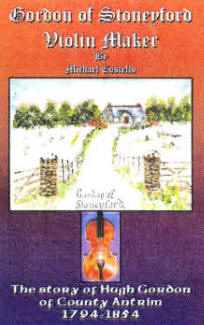
New book brings story of local violin maker back to life
 IT is not unusual to discover amongst the advertising
columns in the newspapers of yesteryear, a Gordon violin for sale. An
example of this can be found in the Belfast Newsletter in January 1877.
IT is not unusual to discover amongst the advertising
columns in the newspapers of yesteryear, a Gordon violin for sale. An
example of this can be found in the Belfast Newsletter in January 1877.
Almost 23 years after the death of local violin maker Hugh Gordon, one of his masterpieces could be bid on at Mr. Cramsie's auction house located at 10 Waring Street, Belfast. Amongst the items for auction on that occasion were "...a Klotz violin, a violin (by Gordon), and a small Mathias Neuner violin..."
For over thirty years, Belfast teacher and musician, Michael Costello has been researching the background of Hugh Gordon, a farmer, blacksmith and amateur violin maker, who resided at Ballymacward, Stoneyford.
Michael, who is also the proud owner of several of Gordon's early 19th century violins, recently launched his newly published book titled 'Gordon of Stoneyford, Violin Maker' at the February meeting of Killultagh Historical Society.
Michael is no stranger to the society. At their meeting in October 2008 he introduced his passion at the public gathering for his first ever lecture. The lecture, which proved to be a success, combined local history with music and song. It was an overwhelming experience for those present to hear the sounds of several locally hand crafted violins return to the area where they had been manufactured over 150 years ago.
A similar lecture was given to Lisburn Historical Society in December 2009. On both occasions Michael supplemented the lecture with a reading from his book which at that time was in the preparatory stages.
The book, a culmination of many years of research, has now been published. It will become obvious to the reader that Michael's talents extend beyond his musical abilities. The book has been written in a style that skilfully weaves historical fact with fiction. Local historians and residents of the Stoneyford area will immediately recognise many of the local place names including The Brown Moss, Hoodstown, Ballymacward, Ballypitmave and the 'Y' Bridge. Many of the local names amongst the neighbourhood, where Hugh Gordon resided in the early 19th century, can also be found throughout the book.
The use of the dialect of the South Antrim area, incorporating Irish Gaelic, old English and Ulster - Scots words brings to life the characters who feature within. It has been stated that "the author gives us an uplifting and often humorous insight into the lives of the South Antrim farming community of that era, from both a social and a musical perspective."
The death of 60-year old Hugh Gordon on the 3rd April 1854 at Ballymacward was a tragedy for his immediate family and the sense of loss undoubtedly experienced amongst the neighbourhood and beyond. Michael's literary talent makes it impossible for the reader not to become emotionally involved in the events leading up to and the passing of Hugh Gordon.
The foreword in the book includes details about Michael's research and facts surrounding the life and work of Hugh Gordon.
Frank Doherty, an octogenarian and accomplished musician, delighted audiences during Michael's lectures to the local Historical Societies when he played an original Gordon Violin. The painting of Hugh Gordon's cottage that appears on the front cover of the new book has now revealed another of Frank's talents - painting. The wintertime scene depicting the Gordon homestead, the "loanin' and stone pillars is an excellent backdrop to another piece of our forgotten local history, now put into print and preserved for generations to come. The book is dedicated to the descendants of Hugh Gordon, some of whom still reside in the Stoneyford and surrounding areas. Copies of the book, priced at £7 each, can be obtained by contacting Michael on 07518631378. £2 from each book sold will be donated to the Haiti Disaster fund.
For further information on the book and Gordon Violins visit Michael's website at https://.m.maccoisdeala.tripod.com.
The Digger can be contacted at diggerarticle@hotmail.com or by contacting the Ulster Star
19/03/2010
